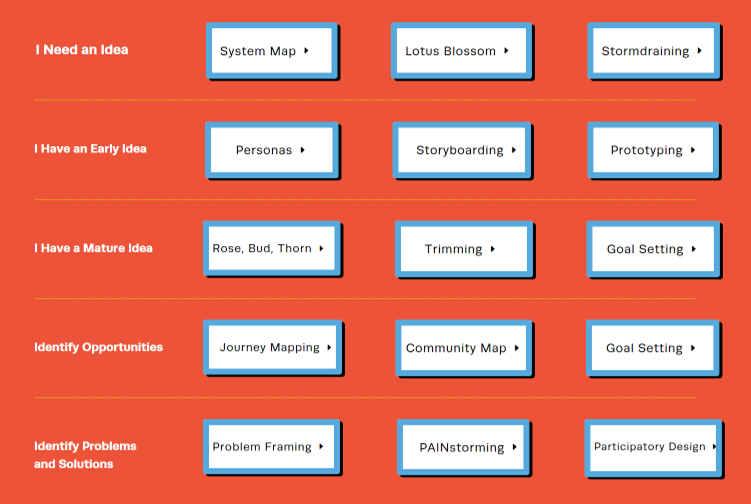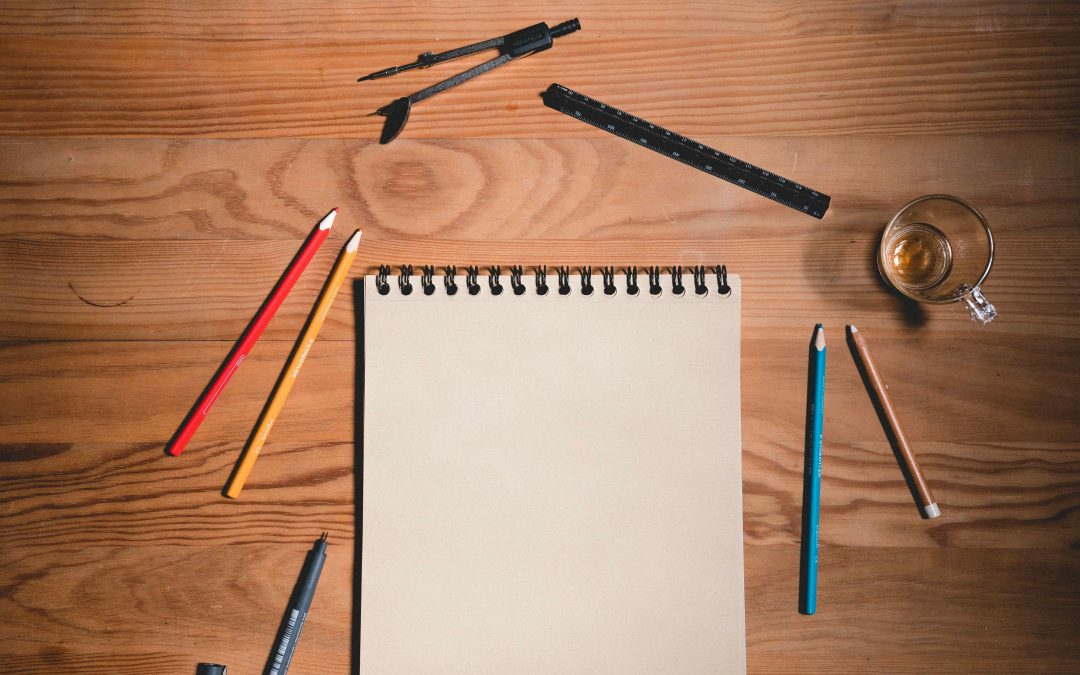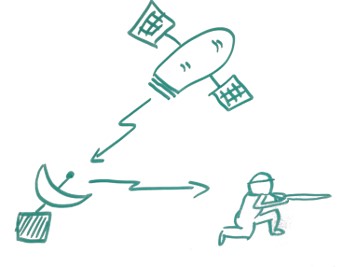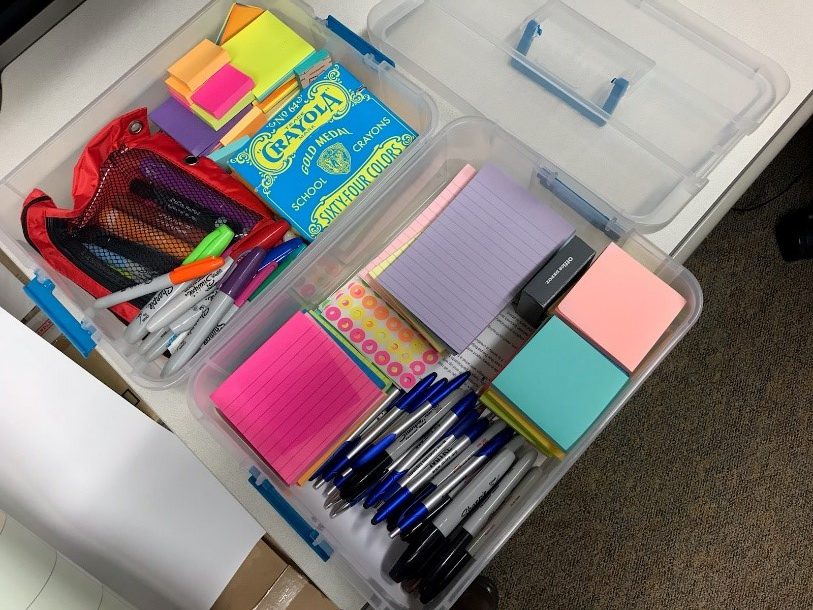
by rgregorio | Feb 25, 2019 | Uncategorized
In a previous post, we talked about how to get started with ITK. In this post we’re taking it to the next level and sharing some Tool Chains for your consideration.
The concept of a tool chain is pretty straightforward. It involves using a series of tools in sequence, where the outputs of one is the input of the next. The image to the right shows a few examples of what a tool chain might look like.
If your project is brand new and you’re not sure where to start, try the I Need An Idea chain. It begins with a System Map to understand the environment and players, followed by the Lotus Blossom for some ideation. It wraps up with Stormdraining to remove options that might not be feasible or a right fit for the system you mapped out.
Have you tried any of the tool chains? Did you use another tool chain that worked well for you? Do the categories help you navigate through the toolkit to identify the right tool for you? As always, we’d love to hear from you! Drop us a note at ITK@mitre.org!

by Stephanie Medicke | Feb 18, 2019 | Facilitation Tips
One of the key benefits of using ITK’s tools is to “get people in a room and talking.” But what if your team is not geographically collocated? That can make things difficult.
Dialing in remotely to a meeting where wall charts and whiteboards are used but not broadcast can be an extremely frustrating experience. It is so critical that the participants who are “remote” feel just as included in the discussion as the participants in the room. So if you find yourself in that situation, here are some recommendations for leading a successful remote working session.
- Be respectful of different time zones and try to pick a time that works for all
- Provide a clear agenda with time boxes and stick to it
- Provide supporting materials and goals for the session in advance so folks can print out ahead of time
- Have an experienced facilitator (perhaps someone not on the team)
- Use tools that capture all the ideas
We’ve got more tips and tricks on good facilitation coming in a future post – watch this space!
For an interesting experiment on remote facilitation, check out this article written by our very own Dan Ward:

by kswhite | Feb 11, 2019 | Uncategorized
Several tools in the Innovation Toolkit invite users to sketch (i.e. Mind Mapping, Prototyping, System Mapping, Storyboarding, etc.), and that can be a little intimidating for some people. While I feel pretty comfortable throwing squiggles and shapes on a page or whiteboard, we often hear comments like, “I can’t even draw a stick figure,” or “I’m no artist.” If this is you, I encourage you to sketch anyway. Here’s why:
 Sketching helps the brain process thoughts in ways that talking and writing can’t. The point of sketching for innovation is not to end up with a classy stick figure or an impressively round-ish circle, but to represent the process of thought and externalize ideas. It inherently embodies qualities that are important for the innovation process. It is naturally iterative, reminds us that failure is ok (thank you erasers!), and requires us to think critically.
Sketching helps the brain process thoughts in ways that talking and writing can’t. The point of sketching for innovation is not to end up with a classy stick figure or an impressively round-ish circle, but to represent the process of thought and externalize ideas. It inherently embodies qualities that are important for the innovation process. It is naturally iterative, reminds us that failure is ok (thank you erasers!), and requires us to think critically.
Remember, thoughts are messy and sketching can be too! In my opinion, the scrappier the sketch, the better. Get a minimum viable sketch out and if it represents a good idea, refine it later. You just don’t know how good an idea is until you get it out, so give yourself permission to scribble, scrawl, and squiggle and you may find yourself looking at a good idea.
Post by Kaylee White, sketch by non-artist Dan Ward

by Aileen Laughlin | Feb 4, 2019 | Facilitation Tips
We got an email recently asking what materials the ITK team brings to their workshops. There’s a lot of work that goes into planning and prepping for workshops and most of the time, materials are the very last thing we address. After a few workshops of lugging around canvas bags filled with markers, post-it notes, and pens we decided to better organize our materials into the physical workshop kit you see in this photo.
Across our different workshops and events, here’s what ITK team recommends as the essentials:
- Tackle or Plastic Organizer box
- Sharpies (especially black and dark colors)
- Post-it/Sticky Notes (at least 2 different sizes and 3 different colors)
- White board markers
- Pens and/or Pencils
- Dot stickers for voting
- Crayons or markers
- Large 3-M sticky pads (easel mounted)
- Tape
We also try to bring 11×17 print-outs of what tools we are using or may use during the workshop. For larger group activities, we try to get larger 3’x4’ printout(s). If you can’t get your hands on those, just supplement with the 3-M easel pads. The goal is to make the data and workshop outputs accessible and visible to attendees.
How about you? What sort of materials do you bring to a workshop or session? Send photos of your workshop kits to itk@mitre.org!
Post by Aileen Laughlin




 Sketching helps the brain process thoughts in ways that talking and writing can’t. The point of sketching for innovation is not to end up with a classy stick figure or an impressively round-ish circle, but to represent the process of thought and externalize ideas. It inherently embodies qualities that are important for the innovation process. It is naturally iterative, reminds us that failure is ok (thank you erasers!), and requires us to think critically.
Sketching helps the brain process thoughts in ways that talking and writing can’t. The point of sketching for innovation is not to end up with a classy stick figure or an impressively round-ish circle, but to represent the process of thought and externalize ideas. It inherently embodies qualities that are important for the innovation process. It is naturally iterative, reminds us that failure is ok (thank you erasers!), and requires us to think critically.